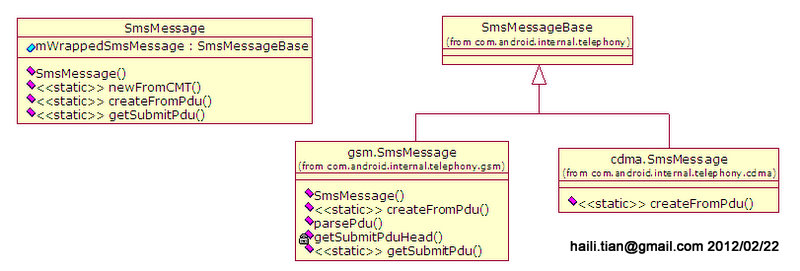原作者地址:http://blog.csdn.net/thl789/article/details/7284383
在解析WAP PUSH over SMS时,看了一下Android里SMS接收的流程,并按照自己需要的流程记录,其他分支的详细处理并未讲述。PDU数据的encode/decode也并未在本文中进行解析,有兴趣的读者可以到相应的代码处自己解读一下。
Android中,RIL用RILReciever接收SMS pdu,并根据不同的信息类型用相应函数来处理。因手机制式的差异,用GsmSmsDispatcher或CdmaSmsDispatcher来做各自的消息处理并分发。最后的分发是通过发送相应的Broadcast,所以,对感兴趣的消息处理,可以注册Receiver来监听相应的Broadcast,实现自己的SMS/MMS/Wap push,以及其他类型消息的接收处理。
RIL构造函数中,Receiver的初始化[在文件RIL.java中]
- mReceiver = newRILReceiver();
- mReceiverThread =new Thread(mReceiver, "RILReceiver");
- mReceiverThread.start();
其中的类型
- mReceiver: RILReceiver
- mReceiverThread: Thread
RILReceiver实现了Runnable

关注RILReceiver线程的实现[在RILReceiver::run()中]
- public void run() {
- int retryCount= 0;
- try {for (;;) {
- LocalSockets = null;
- LocalSocketAddress l;
- try {
- s = newLocalSocket();
- l = newLocalSocketAddress(SOCKET_NAME_RIL,
- LocalSocketAddress.Namespace.RESERVED);
- s.connect(l);
- } catch (IOException ex){
- // 。。。
- }
- retryCount= 0;
- mSocket =s;
- int length= 0;
- try {
- InputStreamis = mSocket.getInputStream();
- for(;;) {
- Parcel p;
- length = readRilMessage(is, buffer);
- if(length < 0) {
- // End-of-stream reached
- break;
- }
- p =Parcel.obtain();
- p.unmarshall(buffer, 0, length);
- p.setDataPosition(0);
- processResponse(p);
- p.recycle();
- }
- } catch(java.io.IOException ex) {
- // …
- } catch(Throwable tr) {
- // …
- }
- // …
- }} catch(Throwable tr) {
- Log.e(LOG_TAG,"Uncaught exception", tr);
- }
- }
RILReceiver线程不停的监听本地Socket,读到数据之后在processResponse()[Line#37]中处理。
- private void processResponse (Parcel p) {
- int type;
- type = p.readInt();
- if(type == RESPONSE_UNSOLICITED) {
- processUnsolicited (p);
- }else if (type == RESPONSE_SOLICITED) {
- processSolicited (p);
- }
- releaseWakeLockIfDone();
- }
如果类型属于Unsolicited消息,则在processUnsolicited()中处理。收到的短信是属于Unsolicited信息,看它的实现。
processUnsolicited()中很长的switch… case语句中对收到短信的处理在case RIL_UNSOL_RESPONSE_NEW_SMS:
- SmsMessage sms;
- sms = SmsMessage.newFromCMT(a);
- if (mSMSRegistrant != null) {
- mSMSRegistrant.notifyRegistrant(new AsyncResult(null, sms, null));
- }
这里的SmsMessage是android.telephony.SmsMessage。newFromCMT()中会根据电话类型(GSM/CDMA)选择具体的SmsMessage进行封装(因为Rational Rose中,同一工程中,不同包内的类也不允许同名,com.android.internal.telephony.gsm.SmsMessage用gsm.SmsMessage代替;com.android.internal.telephony.cdma.SmsMessage用cdma.SmsMessage代替。实际类型都是SmsMessage)。

mSMSRegistrant是RIL父类的成员。通过setOnNewSMS()/unSetOnNewSMS()设置和取消设置。SMSDispatcher的构造函数中注册了SMS的Registrant
mCm.setOnNewSMS(this, EVENT_NEW_SMS, null);

所以,调用mSMSRegistrant.notifyRegistrant(newAsyncResult(null, sms, null))之后,执行的是SMSDispatcher中Handler在handleMessage()中对EVENT_NEW_SMS的处理:
- SmsMessage sms;
- ar = (AsyncResult) msg.obj;
- if (ar.exception != null) {
- Log.e(TAG, "Exception processing incoming SMS. Exception:" +ar.exception);
- return;
- }
- sms = (SmsMessage) ar.result;
- try {
- int result = dispatchMessage(sms.mWrappedSmsMessage);
- if (result != Activity.RESULT_OK) {
- // RESULT_OK means thatmessage was broadcast for app(s) to handle.
- // Any other result, weshould ack here.
- boolean handled = (result== Intents.RESULT_SMS_HANDLED);
- notifyAndAcknowledgeLastIncomingSms(handled, result, null);
- }
- } catch (RuntimeException ex) {
- Log.e(TAG, "Exception dispatching message", ex);
- notifyAndAcknowledgeLastIncomingSms(false,Intents.RESULT_SMS_GENERIC_ERROR, null);
- }
SMSDispatcher是一个abstract的类,dispatchMessage()的具体实现在GsmSMSDispatcher或CdmaSMSDispatcher中。
GsmSMSDispatcher::dispatchMessage()中,会对Class 0类型的短信,有目标端口的短信,和长短信做处理。
目标端口为WAPPUSH的信息,则调用mWapPush.dispatchWapPdu(sms.getUserData(),pdus)让WAPPUSH来处理;其它未知的端口,则用“sms://localhost:<port>”指定端口。
对长短信,调用processMessagePart()进行组合处理。
1) 有目标端口且目标端口是WAP PUSH(SmsHeader.PORT_WAP_PUSH)的信息,用WapPushOverSms::dispatchWapPdu()来处理:
根据不同的contentType:
-> dispatchWapPdu_PushCO();
-> dispatchWapPdu_MMS();
-> dispatchWapPdu_default()
2) 有目标地址且目标端口不是WAP PUSH的信息,在SMSDispatcher::dispatchPortAddressedPdus()中处理:
Uri uri =Uri.parse("sms://localhost:" + port);
Intent intent= new Intent(Intents.DATA_SMS_RECEIVED_ACTION, uri);
intent.putExtra("pdus", pdus);
dispatch(intent, "android.permission.RECEIVE_SMS");
3) 通常的无目标地址的信息(普通短信),在SMSDispatcher::dispatchPdus()中处理:
Intent intent= new Intent(Intents.SMS_RECEIVED_ACTION);
intent.putExtra("pdus", pdus);
dispatch(intent, "android.permission.RECEIVE_SMS");
版权声明:本文为博主原创文章,未经博主允许不得转载。
























 1001
1001

 被折叠的 条评论
为什么被折叠?
被折叠的 条评论
为什么被折叠?








